Abstract
OBJECTIVES: To measure in vivo the cadmium concentrations in kidney cortex (kidney-Cd) and in superficial liver tissue (liver-Cd) of nickel cadmium battery workers, and to compare the results with other commonly used estimates of cadmium exposure (current concentrations of cadmium in blood (B-Cd) and urine (U-Cd)) or repeated measurements of cadmium in workplace air (CumAir-Cd). METHODS: The study comprised 30 workers with a range of duration of exposure of 11-51 years. 13 subjects were currently employed, whereas the other 17 had a median period without occupational exposure of eight years before the measurements. The in vivo measurements were made with an x ray fluorescence technique permitting average detection limits of 30 and 3 micrograms cadmium per g tissue in kidney and liver, respectively. RESULTS: 19 of 30 (63%) people had kidney-Cd and 13 of 27 (48%) had liver-Cd above the detection limits. Kidney-Cd ranged from non-detectable to 350 micrograms/g and liver-Cd from non-detectable to 80 micrograms/g. The median kidney-Cd and liver-Cd were 55 micrograms/g and 3 micrograms/g, respectively. Kidney-Cd correlated significantly with B-Cd (r, 0.49) and U-Cd (r, 0.70), whereas liver-Cd correlated significantly with U-Cd (r, 0.58). Neither kidney-Cd nor liver-Cd correlated with the CumAir-Cd. The prevalence of beta 2-microglobulinurea increased with increased liver-Cd. CONCLUSIONS: Current U-Cd can be used to predict the kidney-Cd and liver-Cd measured in vivo. In vivo measurements of kidney-Cd and liver-Cd were not shown to correlate with the individual cadmium exposure estimates, obtained by integration of the cadmium concentration in workplace air. There may be several reasons for this, including uncertainties in the estimate of the individual cumulative exposures as well as in the in vivo measurements. There was a suggestion of a relation between liver-Cd and tubular proteinuria.
Full text
PDF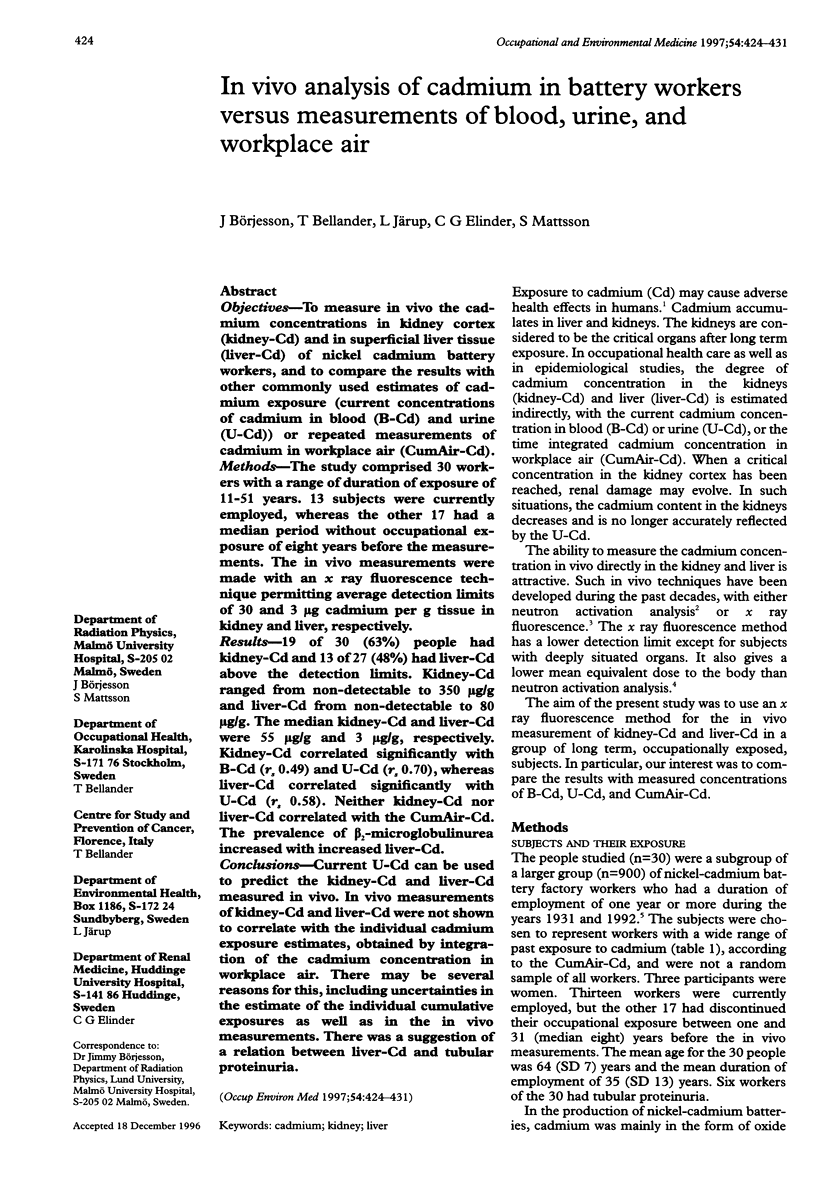
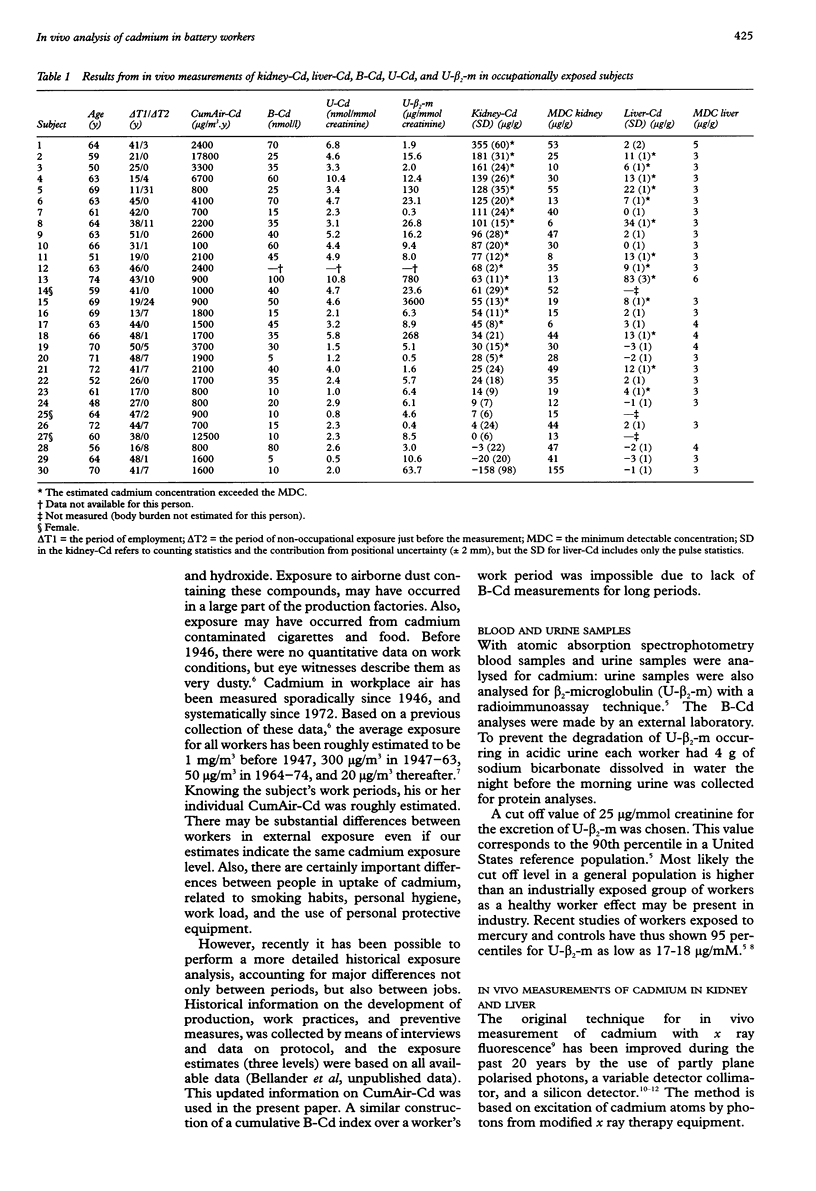
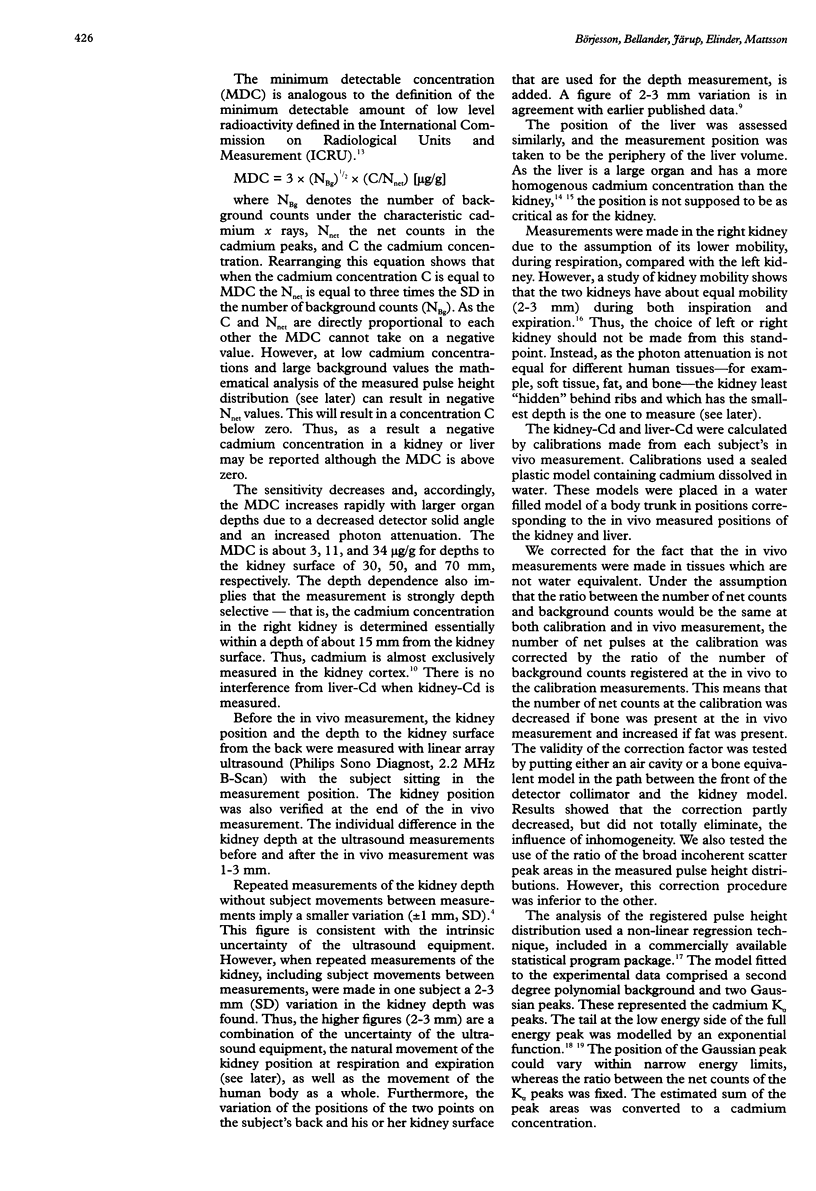

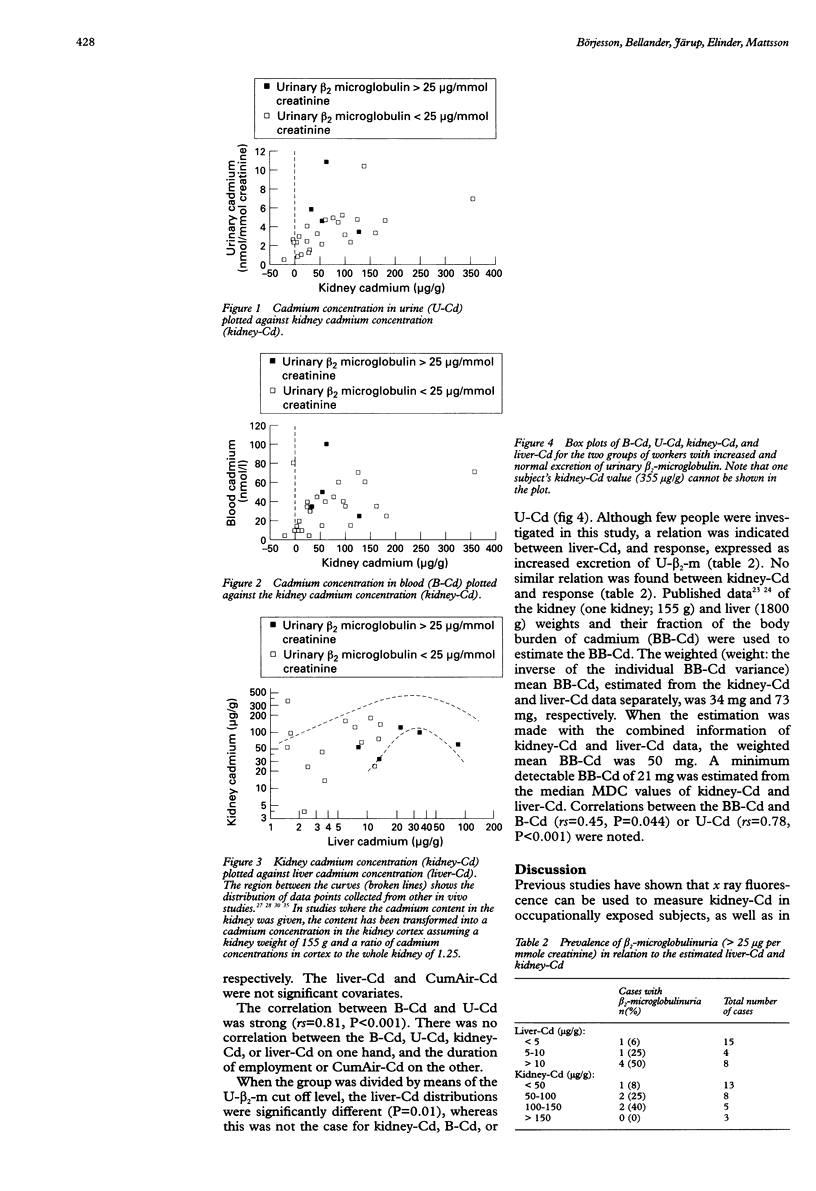
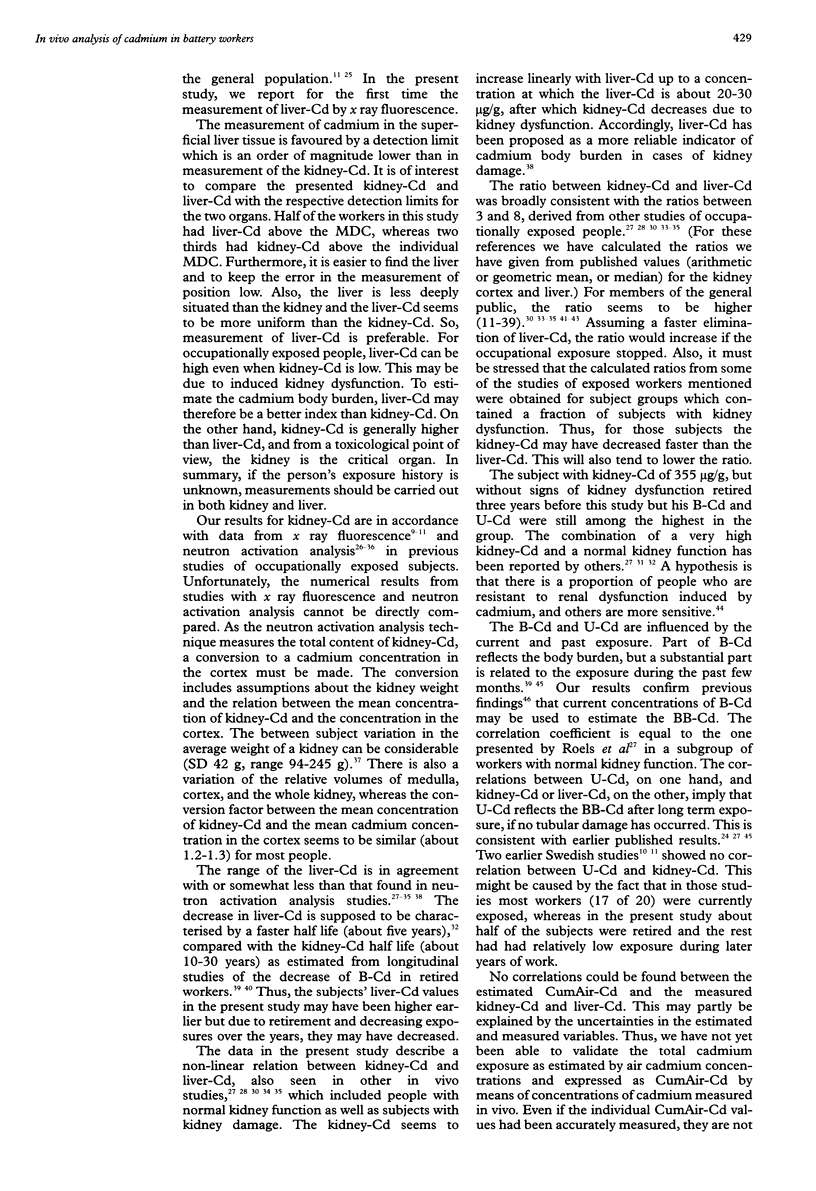

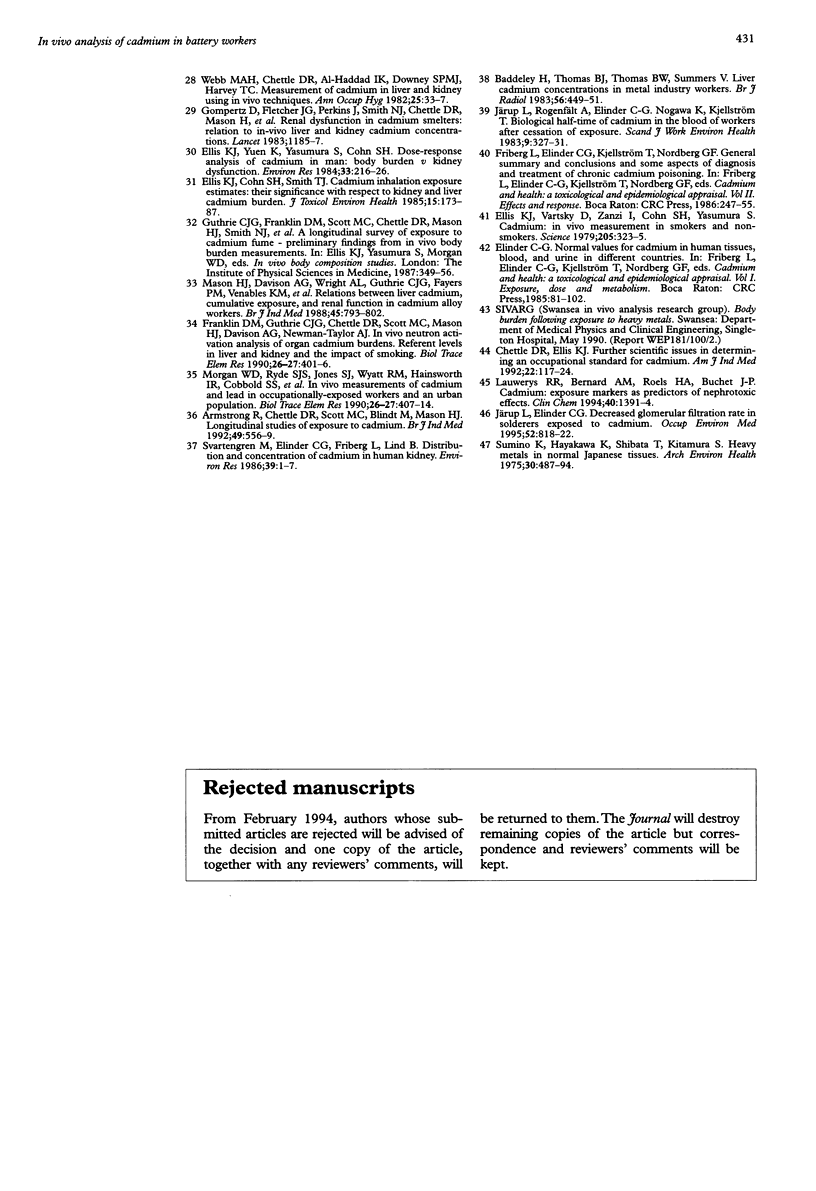
Selected References
These references are in PubMed. This may not be the complete list of references from this article.
- Adamsson E., Piscator M., Nogawa K. Pulmonary and gastrointestinal exposure to cadmium oxide dust in a battery factory. Environ Health Perspect. 1979 Feb;28:219–222. doi: 10.1289/ehp.7928219. [DOI] [PMC free article] [PubMed] [Google Scholar]
- Armstrong R., Chettle D. R., Scott M. C., Blindt M., Mason H. J. Longitudinal studies of exposure to cadmium. Br J Ind Med. 1992 Aug;49(8):556–559. doi: 10.1136/oem.49.8.556. [DOI] [PMC free article] [PubMed] [Google Scholar]
- Baddeley H., Thomas B. J., Thomas B. W., Summers V. Liver cadmium concentrations in metal industry workers. Br J Radiol. 1983 Jul;56(667):449–451. doi: 10.1259/0007-1285-56-667-449. [DOI] [PubMed] [Google Scholar]
- Börjesson J., Mattsson S. Toxicology; in vivo x-ray fluorescence for the assessment of heavy metal concentrations in man. Appl Radiat Isot. 1995 Jun-Jul;46(6-7):571–576. doi: 10.1016/0969-8043(95)00093-3. [DOI] [PubMed] [Google Scholar]
- Chettle D. R., Armstrong R., Todd A. C., Franklin D. M., Scott M. C., Somervaille L. J. Measurements of trace elements in vivo. Basic Life Sci. 1990;55:247–257. doi: 10.1007/978-1-4613-1473-8_33. [DOI] [PubMed] [Google Scholar]
- Chettle D. R., Ellis K. J. Further scientific issues in determining an occupational standard for cadmium. Am J Ind Med. 1992;22(1):117–124. doi: 10.1002/ajim.4700220111. [DOI] [PubMed] [Google Scholar]
- Christoffersson J. O., Mattsson S. Polarised X-rays in XRF-analysis for improved in vivo detectability of cadmium in man. Phys Med Biol. 1983 Oct;28(10):1135–1144. doi: 10.1088/0031-9155/28/10/005. [DOI] [PubMed] [Google Scholar]
- Ellis K. J., Cohn S. H., Smith T. J. Cadmium inhalation exposure estimates: their significance with respect to kidney and liver cadmium burden. J Toxicol Environ Health. 1985;15(1):173–187. doi: 10.1080/15287398509530644. [DOI] [PubMed] [Google Scholar]
- Ellis K. J., Vartsky D., Zanzi I., Cohn S. H., Yasumura S. Cadmium: in vivo measurement in smokers and nonsmokers. Science. 1979 Jul 20;205(4403):323–325. doi: 10.1126/science.377488. [DOI] [PubMed] [Google Scholar]
- Ellis K. J., Yuen K., Yasumura S., Cohn S. H. Dose-response analysis of cadmium in man: body burden vs kidney dysfunction. Environ Res. 1984 Feb;33(1):216–226. doi: 10.1016/0013-9351(84)90018-5. [DOI] [PubMed] [Google Scholar]
- Franklin D. M., Guthrie C. J., Chettle D. R., Scott M. C., Mason H. J., Davison A. G., Newman Taylor A. J. In vivo neutron activation analysis of organ cadmium burdens. Referent levels in liver and kidney and the impact of smoking. Biol Trace Elem Res. 1990 Jul-Dec;26-27:401–406. doi: 10.1007/BF02992694. [DOI] [PubMed] [Google Scholar]
- Gompertz D., Chettle D. R., Fletcher J. G., Mason H., Perkins J., Scott M. C., Smith N. J., Topping M. D., Blindt M. Renal dysfunction in cadmium smelters: relation to in-vivo liver and kidney cadmium concentrations. Lancet. 1983 May 28;1(8335):1185–1187. doi: 10.1016/s0140-6736(83)92465-0. [DOI] [PubMed] [Google Scholar]
- Harvey T. C., Thomas B. J., McLellan J. S., Fremlin J. H. Measurement of liver-cadmium concentrations in patients and industrial workers by neutron-activation analysis. Lancet. 1975 Jun 7;1(7919):1269–1272. doi: 10.1016/s0140-6736(75)92552-0. [DOI] [PubMed] [Google Scholar]
- Järup L., Elinder C. G. Dose-response relations between urinary cadmium and tubular proteinuria in cadmium-exposed workers. Am J Ind Med. 1994 Dec;26(6):759–769. doi: 10.1002/ajim.4700260605. [DOI] [PubMed] [Google Scholar]
- Järup L., Elinder C. G., Spång G. Cumulative blood-cadmium and tubular proteinuria: a dose-response relationship. Int Arch Occup Environ Health. 1988;60(3):223–229. doi: 10.1007/BF00378700. [DOI] [PubMed] [Google Scholar]
- Järup L., Persson B., Elinder C. G. Decreased glomerular filtration rate in solderers exposed to cadmium. Occup Environ Med. 1995 Dec;52(12):818–822. doi: 10.1136/oem.52.12.818. [DOI] [PMC free article] [PubMed] [Google Scholar]
- Järup L., Rogenfelt A., Elinder C. G., Nogawa K., Kjellström T. Biological half-time of cadmium in the blood of workers after cessation of exposure. Scand J Work Environ Health. 1983 Aug;9(4):327–331. doi: 10.5271/sjweh.2404. [DOI] [PubMed] [Google Scholar]
- Kim R., Aro A., Rotnitzky A., Amarasiriwardena C., Hu H. K x-ray fluorescence measurements of bone lead concentration: the analysis of low-level data. Phys Med Biol. 1995 Sep;40(9):1475–1485. doi: 10.1088/0031-9155/40/9/007. [DOI] [PubMed] [Google Scholar]
- Langworth S., Elinder C. G., Sundquist K. G., Vesterberg O. Renal and immunological effects of occupational exposure to inorganic mercury. Br J Ind Med. 1992 Jun;49(6):394–401. doi: 10.1136/oem.49.6.394. [DOI] [PMC free article] [PubMed] [Google Scholar]
- Lauwerys R. R., Bernard A. M., Roels H. A., Buchet J. P. Cadmium: exposure markers as predictors of nephrotoxic effects. Clin Chem. 1994 Jul;40(7 Pt 2):1391–1394. [PubMed] [Google Scholar]
- Mason H. J., Davison A. G., Wright A. L., Guthrie C. J., Fayers P. M., Venables K. M., Smith N. J., Chettle D. R., Franklin D. M., Scott M. C. Relations between liver cadmium, cumulative exposure, and renal function in cadmium alloy workers. Br J Ind Med. 1988 Dec;45(12):793–802. doi: 10.1136/oem.45.12.793. [DOI] [PMC free article] [PubMed] [Google Scholar]
- Morgan W. D., Ryde S. J., Jones S. J., Wyatt R. M., Hainsworth I. R., Cobbold S. S., Evans C. J., Braithwaite R. A. In vivo measurements of cadmium and lead in occupationally-exposed workers and an urban population. Biol Trace Elem Res. 1990 Jul-Dec;26-27:407–414. doi: 10.1007/BF02992695. [DOI] [PubMed] [Google Scholar]
- Nilsson U., Schütz A., Skerfving S., Mattsson S. Cadmium in kidneys in Swedes measured in vivo using X-ray fluorescence analysis. Int Arch Occup Environ Health. 1995;67(6):405–411. doi: 10.1007/BF00381053. [DOI] [PubMed] [Google Scholar]
- Roels H. A., Lauwerys R. R., Buchet J. P., Bernard A., Chettle D. R., Harvey T. C., Al-Haddad I. K. In vivo measurement of liver and kidney cadmium in workers exposed to this metal: its significance with respect to cadmium in blood and urine. Environ Res. 1981 Oct;26(1):217–240. doi: 10.1016/0013-9351(81)90199-7. [DOI] [PubMed] [Google Scholar]
- Schwartz L. H., Richaud J., Buffat L., Touboul E., Schlienger M. Kidney mobility during respiration. Radiother Oncol. 1994 Jul;32(1):84–86. doi: 10.1016/0167-8140(94)90452-9. [DOI] [PubMed] [Google Scholar]
- Sumino K., Hayakawa K., Shibata T., Kitamura S. Heavy metals in normal Japanese tissues. Amounts of 15 heavy metals in 30 subjects. Arch Environ Health. 1975 Oct;30(10):487–494. doi: 10.1080/00039896.1975.10666759. [DOI] [PubMed] [Google Scholar]
- Svartengren M., Elinder C. G., Friberg L., Lind B. Distribution and concentration of cadmium in human kidney. Environ Res. 1986 Feb;39(1):1–7. doi: 10.1016/s0013-9351(86)80002-0. [DOI] [PubMed] [Google Scholar]
- Webb M. A., Chettle D. R., Al-Haddad I. K., Downey S. P., Harvey T. C. Measurement of cadmium in liver and kidney using in vivo techniques. Ann Occup Hyg. 1982;25(1):33–37. doi: 10.1093/annhyg/25.1.33. [DOI] [PubMed] [Google Scholar]


